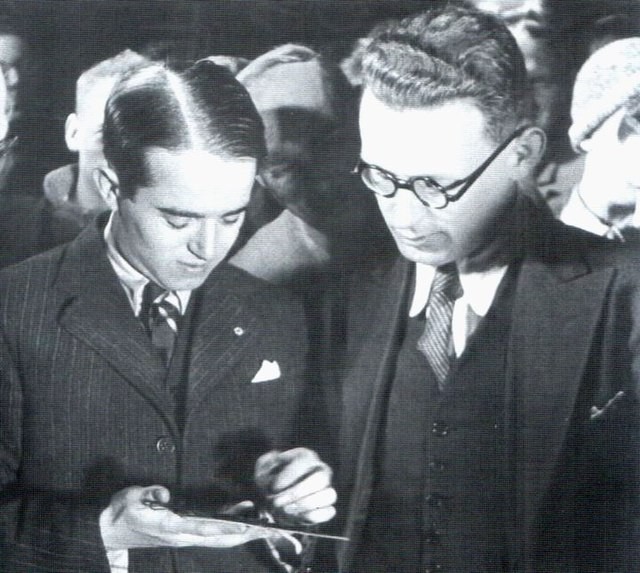
Discovering Salo Flohr: A King Without a Crown in Chess
This post is dedicated to Salo Flohr, one of the great chess masters of the 20th century, who unfortunately remains relatively unknown. We will delve into his life, his chess career, and analyze some of his most memorable games, admiring the quality of his play. We will also examine his playing style and how it influenced future generations of chess players.
Get ready to dive into the fascinating story of Salo Flohr and discover the enduring legacy he left in the world of chess. This post promises to be an exciting and enlightening journey about one of the most remarkable kings without a crown in chess history!
Index:
- Salo Flohr Biography
- Curiosities
- Playing Style
- Annotated Game
- Endgame
- Conclusion / Legacy in chess
- Further Information
Biography
Salomon Flohr was an outstanding Czechoslovak and Soviet chess player. Born on November 21, 1908, in Horodenka, Galitzia, now Ukraine, Flohr displayed exceptional chess skills from an early age.
He worked as a chess journalist, and one of his early assignments was covering the 1928 Berlin tournament, during which he continued to earn money by playing chess. Here's the anecdote: Once, a Czech journalist asked Flohr to accompany him as an assistant to a major international tournament in Kissingen. Although he initially remained in the background, Flohr couldn't resist sharing new ideas and improvements with the players during analysis sessions in local cafes. His profound knowledge of chess as an unknown player caused a stir in the chess community.
Max Euwe, the great chess player, when describing the "emergence" of Flohr after the Kissingen event, said:
"A few weeks later, a major tournament was held in Berlin, and once again Flohr was present as a journalist's assistant, but this time he was no longer unknown. In Café Konig, where the tournament was played, there was another room where chess players regularly gathered. Every day, after lunch, a lively chess life unfolded that only calmed down, after intense battles with the waiters, around 3 a.m. Mostly, informal money games were played. Here was something that Flohr liked! He arrived, he saw, he conquered; and in a few days, everyone in the place, including three or four of the participating masters, owed him money. By then, all the masters knew him, but it would take another year before the international public became acquainted with him."
In the 1930s, Flohr reached his peak, and according to some specialized websites, his Elo rating would have reached 2680 in 1935. Such was his level that by 1937, FIDE had proposed him as the official candidate to face Alekhine for the World Championship. However, the Second World War happened, and it was impossible for him to gather the required funds, so the plans were canceled. During the war, his family was persecuted (as they were Jews), and thanks to his friend Botvinnik, he managed to find refuge in Moscow. This personal situation had such an impact on him that he finished last in the 1938 AVRO super-tournament, and his level had dropped significantly after the war. Without this "misfortune," it is highly likely that he would have become a champion by defeating a struggling Alekhine, which is why he is considered one of the kings without a crown.
He became an International Grandmaster in 1950, being one of the first to receive this title from FIDE. Throughout his career, he won several prominent tournaments and was the Czechoslovak champion in 1933 and 1936. He represented Czechoslovakia in numerous Chess Olympiads, contributing to his team's successful performances.

In addition to his success on the board, Flohr was also a prominent chess writer. He authored numerous articles and books that contributed to the theoretical and practical development of the game. His works are considered valuable for chess players and are still studied today.
Throughout his life, he left a significant legacy in chess, being recognized as one of the great players of his time and a pillar in the game's development. He passed away on July 18, 1983, in Moscow, leaving an indelible mark on the history of chess.

Curiosities
- He was known as "the little Capablanca" due to his height and his similarity to the playing style of the Cuban grandmaster. This was because as a child, he only read books about Capablanca.
-
He followed Capablanca's rules for playing blitz games:
-
Play solid and safe opening schemes.
-
Exchange pieces, at least a bishop and a rook, as early as possible.
-
Simplify to the smallest advantage to transition into a superior endgame.
-
Win games where the opponent has the slightest lack of counterplay.
-
- He was a national hero in Czechoslovakia during the 1930s, and his name was used to endorse many luxury products of his time, including Salo Flohr cigarettes, Salo Flohr slippers, and Salo Flohr cologne
Playing Style
Salo Flohr was known for his solid and technical playing style. He was a player with a deep strategic understanding and exceptional ability to evaluate positions. His approach was based on precision and patience, preferring to slowly build his positions and exploit any small advantage.
In the opening, he often chose solid and well-founded lines, avoiding unnecessary complications. He excelled in his profound knowledge of pawn structures and the ability to find suitable plans in static positions. His positional approach allowed him to establish a strong foundation for the middlegame and endgame.
In the middlegame, he was an expert in long-term planning. He had the ability to accurately assess the available resources in a position and develop strategic plans to improve his position and exploit weaknesses in the opponent's position. He was also a solid defender, capable of withstanding pressure and finding resources to counter enemy attacks.
In terms of tactics, he was a precise and calculating player. Although not known for spectacular combinations, he had a remarkable ability to find subtle tactical resources and make the most of them. His calculations were deep and accurate, allowing him to unravel the complexities of positions and find the best path to victory.
In summary, Salo Flohr's playing style was characterized by his strategic approach, tactical precision, and ability to build solid positions. He was a master of positional play and an expert in developing long-term plans. His cautious yet effective style allowed him to achieve remarkable results against the top players of his time.
He made significant contributions in various defenses, such as the Caro-Kann, which he played in 65% of the games that started with 1.e4.
If you are a beginner and terms like strategy and positional play sound like Chinese to you, read this blog: https://www.chess.com/blog/damafe/chess-strategy-for-beginners
Annotated Game
Now let's take a look at an example of a "model game" to see Flohr's style. It's the game he played against Botvinnik, the future world champion, and with a similar style. We will focus more on Flohr's style rather than specific variations.
Endgame
And finally, let's focus on a very instructive endgame that he played against Spielmann. The white pieces have been controlling the c5 break, which traps the bishop on b7. Spielmann has just played f5 to drive away the knight and finally play c5.
Conclusion
Salo Flohr left a lasting imprint on the world of chess, and his strategic and solid style served as inspiration for many distinguished players. His meticulous approach and ability to construct solid positions influenced the playing style of several prominent chess players, including Anatoly Karpov, who became World Champion and excelled with his solid and positional style. Flohr demonstrated that precision in calculation and patience in long-term planning could be powerful tools in the game of chess. His legacy endures in the subsequent generations of chess players, who have incorporated his teachings into their own strategic approach and continue to admire his contribution to the game.
I hope you have been able to appreciate the quality and importance of Flohr and consider him as a king without a crown, on par with Keres, Bronstein, or Korchnoi. 😉
Further Information
If you want to learn more about Flohr, there are several websites. Here are some of them. Many of his games, especially endgames, can be found in numerous books. For example, "Endgame Strategy" by Shereshevsky analyzes six endgames played by Flohr (few players have more). I took the analyzed endgame from that book.
Silman's article : https://www.chess.com/article/view/salo-flohr-and-the-fickle-winds-of-fate
Wikipedia:
https://es.wikipedia.org/wiki/Salomon_Flohr
https://en.wikipedia.org/wiki/Salo_Flohr
chess.com: https://www.chess.com/players/salo-flohr
chessgames: https://www.chessgames.com/player/salomon_flohr.html
A more comprehensive biography: https://hmong.es/wiki/Salo_Flohr
Another biography: https://dgriffinchess.wordpress.com/2021/08/08/salo-flohr-1908-1983/
7 Chess Endgame Magicians: https://www.chess.com/article/view/chess-endgame-magicians
Openings with his name (there are more):
- https://www.chess.com/openings/Caro-Kann-Defense-Classical-Flohr-Variation
- https://www.chess.com/openings/English-Opening-Mikenas-Carls-Flohr-Variation-4...Ne4
- https://www.chess.com/openings/Grunfeld-Defense-Burille-Paris-Flohr-Defense
- https://www.chess.com/openings/English-Opening-Kings-English-Nimzowitsch-Flohr-Variation
- https://www.chess.com/openings/Alekhines-Defense-Modern-Main-Line-Flohr-Variation
- https://www.chess.com/openings/Ruy-Lopez-Opening-Morphy-Defense-Keres-Flohr-Zaitsev-System
My blog about how to play with the bishop pair: How to play with the bishop pair?
Top 10 games of the 30's: https://www.chess.com/blog/SamCopeland/flohrs-bishop-pair-masterpiece-best-of-the-30s-botvinnik-vs-flohr-1933
Salo Flohr sabout GM title: https://www.chess.com/blog/ddtru/salo-flohr-on-grandmaster-title-1
I have translated this from Spanish with the help of ChatGPT. If there are any errors, please comment on them so that it can be written better, and I can improve my English. ![]()
Spanish version: https://www.chess.com/es/blog/damafe/descubriendo-a-salo-flohr-un-campeon-sin-corona


